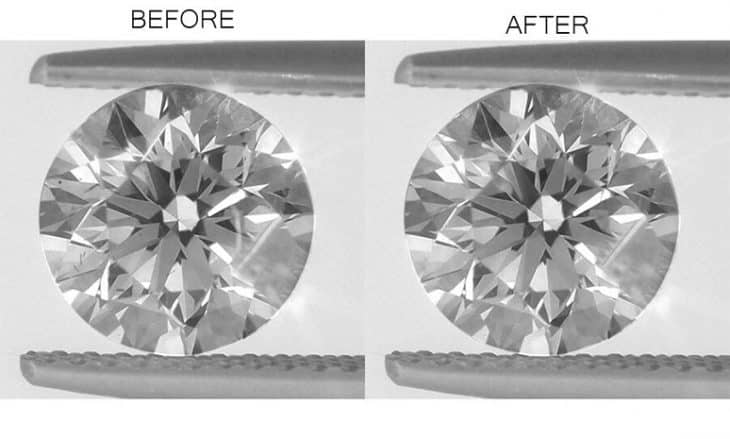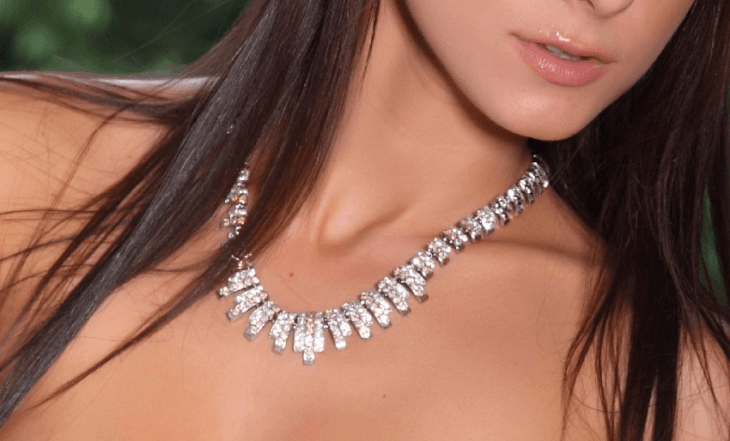
CLARITY ENHANCED DIAMONDS: YOUR ULTIMATE GUIDE
Looking for high-quality clarity enhanced diamonds and don’t really know where to start? Don’t worry, you’re not alone. There are many different grades of diamond clarity and enhancements available today, and most people don’t really know what qualities to look for in their search for the best clarity enhanced diamonds.
So before we dive in, let’s help clarify some important terminology relating to enhanced stones. Natural earthen stones and clarity enhanced diamonds are celebrated for their extraordinary capacity to handle light in a remarkable way. Their ability to sparkle and scintillate – or bounce light reflection from their surface – has fascinated gemstone lovers for centuries. Most consumers today are familiar with the 4Cs of a diamond—Cut, Carat weight, Color, and of course, Clarity. Clarity in regards to diamonds refers to inclusions (another word for flaws) or the lack of them present in a diamond crystal when observed at 10X magnification. So, you can see how important clarity is to a diamond’s beauty and of course its value.
The higher the clarity in a diamond (or fewer inclusions), the greater the price will be paid for that stone. Clarity issues affect how brilliant and dispersive a stone appears. That’s why diamond consumers are always concerned with the clarity of the diamond they want to purchase. The trouble is, there are very few diamonds produced in nature that are free from inclusions—or have a high clarity rating ascribed to them. So, technology has come up with several methods to improve on nature, and deliver a diamond whose clarity has been raised through any number of enhancement methods. That way, more consumers today are enjoying clearer more sparkling diamonds than at any time in history—and they are acquiring these gorgeous stones as affordable prices.
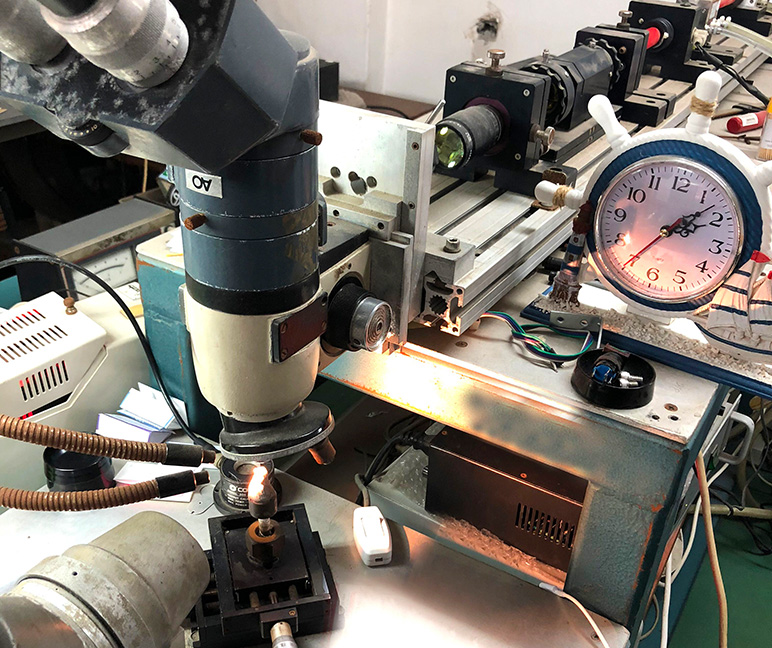
The clarity factor—one of the 4Cs of a diamond’s quality scale, cannot be overlooked. Because this characteristic, can be summed up to convey how well (or not!) light passes through the stone and is scattered through all areas of a diamond. While diamond crystals themselves are most often transparent, it’s likely that the natural crystal will contain numerous naturally occurring defects called inclusions. These inclusions—or blemishes, or flaws– can present as a variety of defects. For example, they may appear as small cracks inside the diamond which happened during the stone’s formation. But, there are structural defects like clouds (micro-minute particles grouped closely together, or other bits of minerals trapped within the diamond. When light passes through the stone and hits these natural inclusions, it makes the reflected light to bounce irregularly causing the diamond appear less clear—less sparkly, we’d say.
Inclusions in all gemstones are so common, it’s one of the ways scientists use to determine a gemstone’s authenticity and species. These distinct growth patterns are very common in diamonds. In fact, it’s a very rare event for a diamond to be found with perfect clarity—having no inclusions whatsoever. These almost unheard-of diamonds are prized for their rare beauty and sell for enormous sums of money to collectors who understand their value However, thanks to advancements in diamond technology today, consumers who have a fine taste for exceptional diamonds—but have an average person’s budget, are able to enjoy owing these spectacular stones—and enjoy them for a lifetime. Today, there is no need for an inclusion to reduce the clarity of a diamond. Using clarity-enhancing techniques, the inclusion in a natural diamond to stay that way. Through technology, it can be remedied in such a way so that it can handle light scatter it throughout the entire diamond as though it came out of the ground with perfect clarity.
How do Diamonds Become Clarity Enhanced?
First things first in discussing clarity enhancement processes. It’s key understanding first of all, that clarity enhanced diamonds are not a manufactured product. They are natural—earth mined real diamonds whose clarity grade is lower than desired. These natural diamonds get the star treatment to up their clarity rating through one of several processes in order to become a high-clarity dazzling diamond that anyone would be proud to own.
Clarity enhancement in diamonds occurs when the crystals go through some special treatment to improve their clarity and reduce the appearance or number of inclusions and look more blemish-free: through laser-drilling, deep boiling, or even fracture filling that results in an improvement to that diamond. Its objective, of course, is to markedly improve the clarity of the stone. Following the treatment, the blemishes and flaws are eradicated, thus raising its clarity ranking. Diamonds that have been subjected to any of these laboratory processes are commonly called CE or clarity enhanced diamonds.
Even if this blanket term for diamond treatment is new for you, it may surprise you to learn that CE diamonds are among the most sought-after options that couples consider today when shopping for that all-important engagement ring—especially those shoppers where budget is a priority. However, before jumping into the CE diamond quest, taking enough time to research and fully understand all about clarity enhanced diamonds—both the pros and cons will make you a much savvier consumer, and ultimately more pleased with your purchase.
Benefits of Clarity Enhanced Diamonds over Natural Stones
Let’s say you are a customer looking for the largest stone possible—while still keeping your budget in view. At such affordable prices, just maybe clarity enhanced diamonds are actually the perfect fit for you. Clarity enhanced diamonds are always offered at much more attractive prices than their natural (untreated diamond) counterparts. You can be assured of substantial savings on your purchase, while still ending up with a very sizable and gorgeous stone. But here’s the caveat; always make sure you buy from a reputable jeweler who’s an expert in this niche diamond market. They will have had hopefully decades of experience in selling this glamorous product and know all the ins and outs of its manufacture including what consumers need to know about its care. With clarity enhanced diamonds, there is the consideration of durability, especially for stones that have undergone laser drilling.
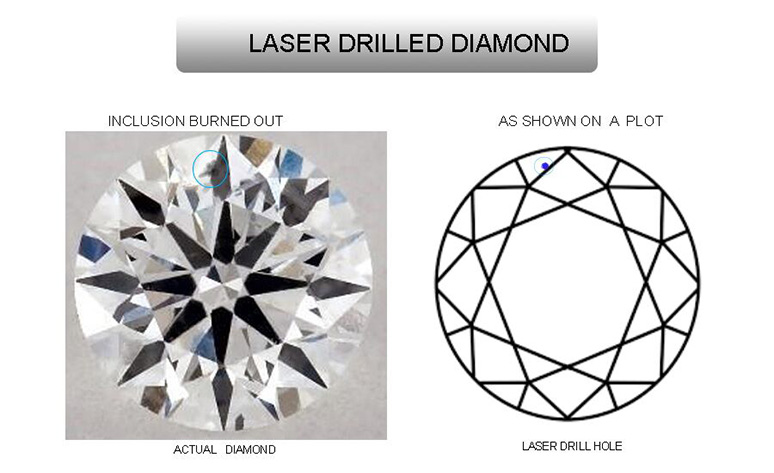
For instance, if the treatment resulted in too many tunnels in the process of removing internal inclusions—this can affect the overall integrity of that particular stone. Reliable CE diamond dealers and vendors are going to make sure that the stones they offer conform to stringent guidelines that ensure your diamond will not be unduly lasered to the extent that its durability is compromised. Finally, understand that in some cases, fracture fillings may not be permanent for the life of that ring. It’s always mandated that the owner advise anyone working on her diamond to tell the jeweler ahead of time that the stone has been clarity enhanced prior to any work being done on the piece—whether it’s at the jeweler’s bench, or even when cleaning the item.
Consider the Pros about Buying a Clarity Enhanced Diamond
– Considerably larger carat weight diamond for your budget
– Higher quality stone while staying inside the budget range
– These stones are genuine earth mined diamonds
– Remarkable savings for compared to same size and quality non-treated diamond
– Popular option as clarity enhanced diamonds increase in the market
The Cons to Consider with a Clarity Enhanced Diamond
– Treatment can be compromised when subjected to extreme heat or corrosive elements
– Disclose enhancements to jewelers working on cleaning, repairing or resizing your ring
– Personal preferences concerning having a ‘treated’ stone
As you can see, there are more pros than cons to considering if a clarity enhanced diamond is right for you. But read on; because we want to tell the entire fascinating story about this remarkable process and how it affects the diamond of your dreams.
Overall, color enhanced diamonds (achieved by a completely separate laboratory treatment) and clarity enhanced, or CE diamonds offer outstanding value when your goal is shopping for higher quality, larger and a more affordable selection of genuine earth- mined diamonds. So, whether your top consideration is to purchase on a definite budget or even if it’s to upgrade the carat size and appearance of your current diamond, today’s clarity enhanced diamonds may be just perfect for you. The top tier clarity enhanced diamond merchants today offer diamond certificates with their clarity enhanced diamonds—and written documentation about the quality of their goods. These are all value-added components that increase your confidence in knowing that your retailer is providing you with the finest in clarity enhanced diamond products.
How To For Beginners: Natural -v- Enhanced Diamonds
When shopping for fine jewelry, a consumer quickly learns that in the world of precious gemstones, diamonds are divided into two main categories: natural untreated diamonds and those that have undergone some form of treatment –collectively referred to as enhanced diamonds. Both are naturally formed and mined in the earth. After their recovery, they are cut and polished to the desired shape and size—ready for the consumer. Yet irrespective of their similar origins, clarity enhanced diamonds carry a considerably more affordable market price than their untreated counterpart. Consumers can expect to get a larger, brighter, clarity enhanced stone for the same price one would pay for a smaller, untreated natural diamond. To call them natural diamonds indicated they are not treated in any way whatsoever. So that untreated stone displays its own naturally-occurring quality components and characteristics. However, a clarity enhanced diamond can be compared to one getting the full spa beauty treatment. Its enhancement methods have resulted in a clearer more brilliant stone that looks remarkably sparkling—bright—and white—something that is exceedingly rare in the natural world.
Diamond Clarity Enhancement Essentials
The Basics: Enhancement Methods for Treating Diamonds
Geared to increasing the allure of a diamond by improving its clarity or sometimes the color, diamonds undergo one of several treatments employed to enhance the stone by reducing the appearance of naturally-occurring blemishes that adversely affect its transparency, color, and of course its sparkle. Over time, several methods have been developed to bring about the desired result. These are the most successfully utilized procedures that are found in the diamond trade today.
- Laser
- Fracture Filling
- HPHT
- Deep Boiling Techniques
When the objective is improving the clarity of a diamond, it is usually accomplished by laser drilling or fracture filling to remove dark inclusions, or to fill the fractures with a clear resin that mimics the handling of light that an untreated diamond displays.
This procedure is conducted on diamonds whose dark colored inclusions do not fully reach the surface of the crystal. With these stones, a microscopic hole is burned via a laser-beam from the outer surface of the stone inward to its dark (sometimes black) inclusion found deep within the diamond When the initial passageway has been opened up, then the diamond is deep boiled which should remove the dark color from the inclusion. This technique leaves a small, but detectable laser-tunnel inclusion from the surface to the inclusion in the stone. A reputable dealer will disclose this (and other enhanced techniques) to the consumer prior to purchase.
A variation of the afore mentioned laser drilling process is conducted; instead of burning a minute laser tunnel from the diamond’s surface inward to its black inclusion, a microscopically narrow plane is burned through the crystal until it reaches that dark inclusion.
The appeal of this method is distinct; Despite the creation of a larger area than the tunnel than the former laser process, in this instance the flat-plane inclusion is easier filled than that which is created by a regular laser drill.
The two main methods of filling an enhanced diamond for clarity are: first, the method known as feather filling or either fracture filling—those are the most common expressions to convey the work being done. A proprietary glass-like substance is forced into the diamond under great pressure. It then fills up feathers or cracks on or in that stone being treated, thus allowing light to go through the stone in the same manner it would if that stone was originally perfectly clear- the improved clarity is remarkable.
Another method of enhancing diamond clarity involves laser drilling. A laser drills tiny holes into the diamond so impurities, such as mineral deposits, can be bleached. The laser holes are invisible to the naked eye. In this way, the fractures seemingly disappear – leaving a newly revealed high clarity stone that looks dazzling. If the stone’s color needs to be enhanced as well, this can be accomplished through the use of high-pressure high-temperature treatment (HPHT).
Enhanced v Non enhanced or Natural Stones
Laser drilling may use extreme heat, or it may include injecting chemicals into the diamond, to reduce discolorations and render the small inclusions much less visible. Depending on the condition of the original diamond crystal, laser drilling may be followed with fracture filling to further lessen the visibility of any remaining small cracks. Fracture filling includes the addition of a glass-like resin forced into the diamond under extreme pressure which closes those small cracks, making slight imperfections indistinguishable to the human eye. But to permanently alter the color of the diamond which may also be warranted, HPHT treatment may be added. This fascinating method of diamond enhancement employs a cubic press which recreates the conditions under which natural diamonds were formed miles below the surface of the earth. Depending on which particular chemicals were used, the resulting diamond will either exhibit an attractive color or be highly colorless following the regimen.
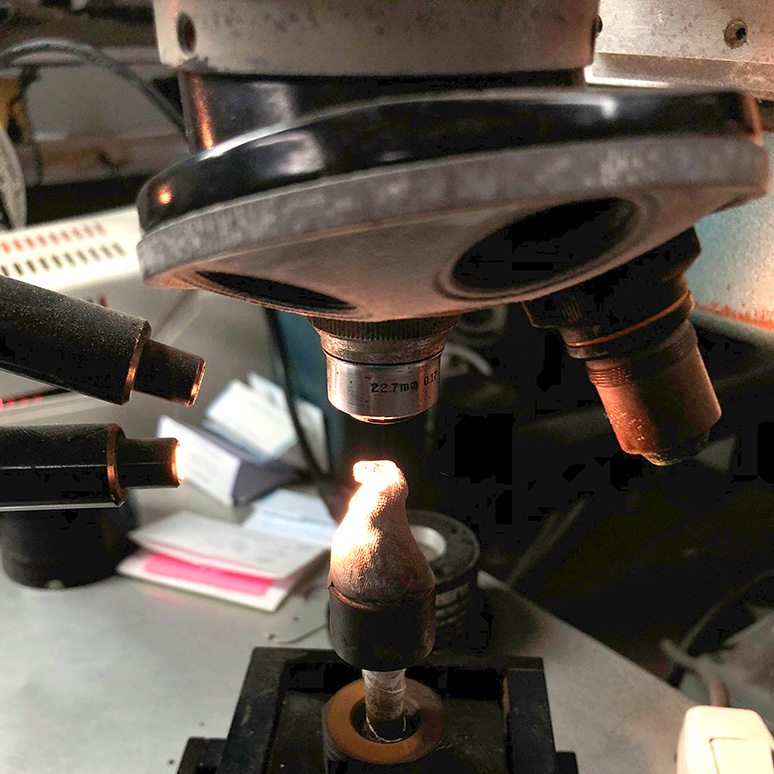
Enhancing a diamond by methods of fracture filling should result in making the stone look unblemished (near flawless) to the naked eye. However, there are more than one types of fracture filling resins available to the trade these days. Depending on the exact substance used to fill in the imperfections, some stones may show even more flaws when the treatment is complete. Certain fillers produce an appearance of a flowing, glassy-looking substance within the stone. But other fillers are said to reveal voids within the filling where air bubbles have developed during the process. For example, a shallow area near the stone’s surface which was not completely filled may in the end appear like a whitish scratch on the face of the diamond. Stones with thick, filled fractures may occasionally appear to have a crackled, web-like appearance.
There is one type of clarity enhancement process that is actually sanctioned by the Gemological Institute of America, known to most consumers simply as GIA. But not every diamond is a candidate for this particular treatment—so that is why so few consumers are even aware of its existence. The method involves deep boiling the diamond under conditions of deep pressure in a specially formulated acidic solution. Interestingly enough, this procedure is only effective on diamonds whose inclusions are actually black (or exceedingly dark) and are surface reaching. This is because if the inclusion (cavity) did not actually reach the outer surface (the facets) of the finished polished diamond, then there would be no entry port for the acid, thus no way of it penetrating the fracture.
Beauty and Savings in One Diamond
When considering purchasing an enhanced diamond, you may focus on the cost savings first of all.
Saving money on your new diamond purchase is one of the top benefits of choosing an enhanced diamond over a natural untreated one. Although prices vary somewhat from retailer to retailer, on average, the enhanced diamonds will cost somewhere between 30 up to 50% less than comparable counterparts (gauged by size and quality) which are natural and untreated. Many consumers first shop for a diamond that is completely colorless (graded D on the color scale) and free of internal imperfections. This of course narrows down their selection of diamonds to choose from, to only those of the highest caliber, and thus keeps their search in the highest price range possible. Clarity enhanced diamonds offers a smart consumer the option of finding a high clarity (by way of enhancement) diamond, and much larger all while staying inside their budget.
What Happens After Enhancement
First Impressions–Fracture filled clarity enhanced diamonds reveal a noticeable improvement in their appearance following treatment. The original imperfections found in the stone are actually no longer visible by the naked eye. Small cracks and even feathering (another type of flaw) seem to somehow magically disappear. If bleaching solutions are then injected into the stone, it reveals a dazzling diamond void it of any unwanted color.
While the sparkling stone and attractive cost of your clarity enhanced diamond appears to make it a no-brainer choice, you still need to consider all aspects of this stone–including the durability of your diamond over its lifetime (and yours!) to make sure you’re making the best choice for you.
Cleaning & Care of Your Enhanced Diamond
Let’s talk cleaning your clarity enhanced diamond. All jewelry benefits for regular maintenance and cleaning to keep it looking its best for years to come. Diamond bridal jewelry is meant to be worn everyday for your entire life. So, it’s bound to pick up dirt and grime from everyday wear, even with careful handling. Did you know that diamonds have a natural property to them that makes dirt attracted to them? All true. So, with that in mind, you want to consider some regular cleaning of all your diamond jewelry so they look showroom fresh.
Like other fine valuables you may own, clarity enhanced diamonds require some thoughtful care with regards to cleaning them from time to time. You probably already know this–many chemical jewelry cleaners on the market today use a formula containing ammonia as one of its primary ingredients. The chemicals inherent to ammonia products can adversely affect the enhancement-areas of your diamond. Because of that, you will want to guard your diamond’s enhancement by only choosing ammonia-free jewelry cleaners when you maintain any of your jewelry items containing an enhanced diamond. Knowledge is power and this bit of information will go a long way to ensuring that your diamond will look as fabulous years from now as it did the day you first put it on your finger. If you take your clarity enhanced diamond to your local jewelry store for a thorough cleaning, be prepared that they are most likely using either a steam device or an ultrasonic (with high level vibrating sound waves) cleaning machine. The heat generated from the steam may cause you enhancement filler in your diamond to degrade and leak out of the stone. Alternately, it might expand the filled area, causing the original fracture to widen. Of course, you don’t want either of these occurrences to happen with your precious diamond. So, by controlling the cleaning yourself, or asking your jeweler if they are using clarity enhanced safe cleaning methods—you’ll avoid any of these unnecessary pitfalls.
In a study conducted by professionals with GIA (Gemological Institute of America} they determined that extended ultrasonic cleaning can result in damage to the enhancement filler, thus affecting its clarity. Researchers discovered that depending on the filler’s chemical composition used for the enhancement process, a filler may be observed at the diamond’s surface and visible after 90 minutes of ultrasonic cleaning. This is quite a bit longer than normal cleaning time, but still for purposes of discovery, it was noted that the adverse reactions could occur.
Careful wear and common-sense tips for keeping your clarity enhanced diamond looking new will ensure a lifetime of enjoyment of your clarity enhanced diamond jewelry, especially rings that come in contact with more elements than other jewelry. It’s always a good idea to remove your jewelry before playing any athletic activities or even working out, or doing manual labor. Because in those situations, it may be more likely you could damage your diamond jewelry—even those pieces that are not clarity enhanced. But what about those times when you need to take your clarity enhanced diamond to the jewelry store for some repair work? Things as normal as re-tipping—a process where the diamond prongs are strengthened and restored, to polishing the piece for a fresh shiny look, most jewelry stores offer a variety of basic repairs. However, if you should decide to take your clarity enhanced diamond ring in to the bench jeweler for a little freshening up, do not neglect to inform your jeweler that the item is a clarity enhanced diamond piece prior to any work being done on your property. If you fail to inform them that your diamond is enhanced, you may end up with an unrecognizable stone after the repair—something that is completely avoidable. Communication is key with clarity enhanced diamonds.
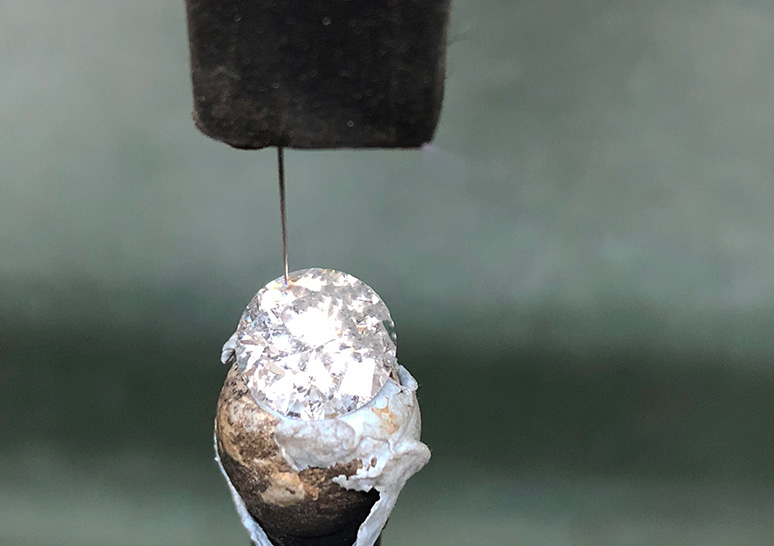
Communication & CE Diamonds
Another type of repair that warrants caution ahead of time to an enhanced diamond is when you take your item in for re-polishing the diamond itself. Most owners will never want or require any stone re-polishing so this is not a major concern. But just to be comprehensive, we should review a bit on this topic. Testing shows that depending on the type of filler used, some stones subjected to re-polishing were observed to have lost filler on the surface of the stone. When that happens, the resulting impression of the stone, especially observed up close or under a jeweler’s loupe is a somewhat pitted appearance. Others observed different stones may have later formed more gas bubbles or developed an internal cloudiness inside the original fracture.
Informing your jeweler about your diamond’s enhancement procedures is the surest way to guard it. Your jeweler will thank you because he or she knows what to do in order to protect it from unintentional damage. You both will be happy with the results of work done on your diamond when you remember to tell your jeweler about your special diamond. One of the things you may consider, (depending on the type of work being carried out (is to request your jeweler to un-mount the stone from the setting prior to performing any work that requires heat applied to it.
A common companion goal with the enhancement of a diamond is often to make it colorless. But that can be a separate procedure, and unless your diamond has received an HPHT treatment, there is no absolute guarantee that its improved color is permanent. Sometimes people confuse clarity and color insomuch as a low clarity diamond can look dark –or greyish owing to its dark colored or numerous inclusions prior to enhancements. But color and clarity are really separate characteristics of a diamonds quality components.
Think about your lifestyle. Are you one that spends a lot of time out in the sun during the warm summer months? GIA researchers simulating the effect of strong sunlight on enhanced diamonds observed that following around 60 hours of exposure to long-wave UV radiation (which is the equivalent of 1,000 hours of being in the sun), some fillers showed discoloration within the diamond. We say this to cover all bases in disclosure—but ask yourself, would you likely be sunning yourself for 1,000 hours—straight or otherwise while having your clarity enhanced diamond on? Not likely—still, research is research and we simply convey findings that we have learned.
Laboratory Reports and What to Expect
One of the important documents that many diamond jewelry owners have with their jewelry is a grading report from a gemological laboratory –like those operated by GIA to evaluate diamonds and colored gemstones. A natural diamond can be submitted for grading by any number of reputable labs like the GIA, to assess their qualities that affect the value of their diamond. The GIA in particular has a policy of not issuing grading reports on clarity enhanced (filled) diamonds because the treatment creates a new clarity and sometimes even modified color to the stone following its treatment—which did not occur in nature. When it concerns stones treated only by laser drilling—that is another story. GIA does examine and issue grading reports on those diamonds which have had only laser drilling enhancement procedures. The reason for this is because the laser process does indeed create permanent changes to that treated diamond.
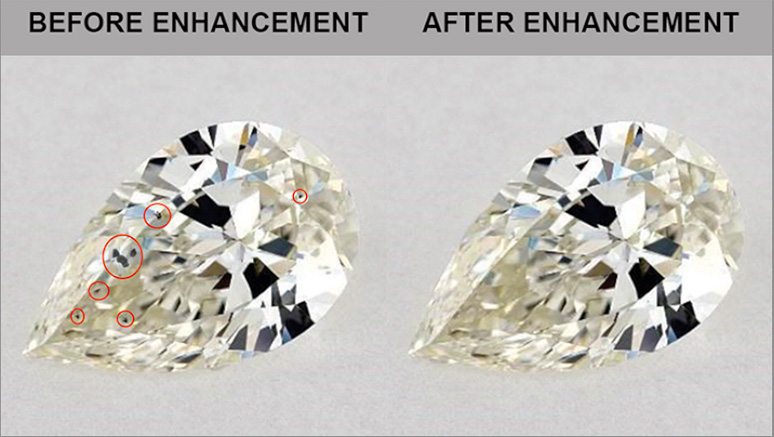
GIA does issue a type of identifying report on other clarity enhanced diamonds brought in for examination. These documents declare the identity of the stone with a notation that a clarity-enhancing, foreign material was introduced into the diamond’s surface-reaching features. This is sometimes useful for consumers who did not know their diamond was enhanced—because they got it from a second party.
Purchasing any kind of diamond is a thoughtful investment of both time and money, so it’s vital that a shopper takes enough time to learn as much as possible about the various diamonds on the market today. That way, you have the assurance that when you’ve finally made your decision, you’ve thought it through and selected the perfect type stone for your needs. Diamonds represent a substantial financial commitment, and that’s certainly the case with a large purchase, as when selecting engagement rings. This is also an emotional purchase, there is so much heartfelt sentiment placed on the engagement ring. No matter what other jewelry a woman owns, this one will be especially treasured. Bridal jewelry is meant to last a lifetime and be worn daily, so you will want to be clear on your selection—and when you finally say “that’s the one” you are getting the perfect stone, and the finest quality of diamond that fits your budget. That’s why more and more modern couples are choosing to select clarity enhanced diamonds as their diamond of choice after a long careful search. Of course, we can’t overstate that clarity enhanced diamonds are indeed natural diamonds, but they are treated in such a way which allows buyers to get a larger, very impressive and more brilliant diamond for less money than they could otherwise afford.
How Is Diamond Clarity Enhanced?
Note that the Geological Institute of America (GIA) does not grade diamonds which have been enhanced with fracture filling. This is because fracture filling substance is not considered part of the diamond; however, the
You should also be aware that clarity enhancement is not the same as color enhancement. Diamond color can be enhanced using methods such as irradiation, high pressure and high temperature (HPHT) treatment, or applying a coating may be used. Many clarity enhanced diamonds may also be color enhanced.
Pros and Cons of Clarity Enhanced Diamonds
There is a lot of debate surrounding clarity enhanced diamonds, with some people saying that they are akin to fakes and others swearing by the beauty of the diamonds. Most of the controversy stems from the fact that many people do not understand what the process of clarity enhancement involves. A clarity enhanced diamond is still a real, natural diamond; however, it has been modified to improve appearance, but arguably, all cut diamonds have been modified to make them look better.
The main benefit of clarity enhanced diamonds is that they allow buyers to get a large diamond for less money. This is because perfect clarity diamonds are very rare and diamonds with inclusions are cheaper. Once the diamond has had its clarity enhanced, it will be more beautiful with better light refraction and more sparkle.
There remains a sector of shoppers who still would rather buy a smaller carat sized untreated diamond than a larger clarity enhanced stone for basically the same money. And that is perfectly fine. But really, the only downside if you can think of it– to clarity enhanced—or treated diamonds is that some special care needs to be considered during a cleaning or when left at the jeweler for repair if fracture filling was used. Once you’ve told your jeweler that the diamond is enhanced –they can make the proper accommodation for you to safeguard its beauty.
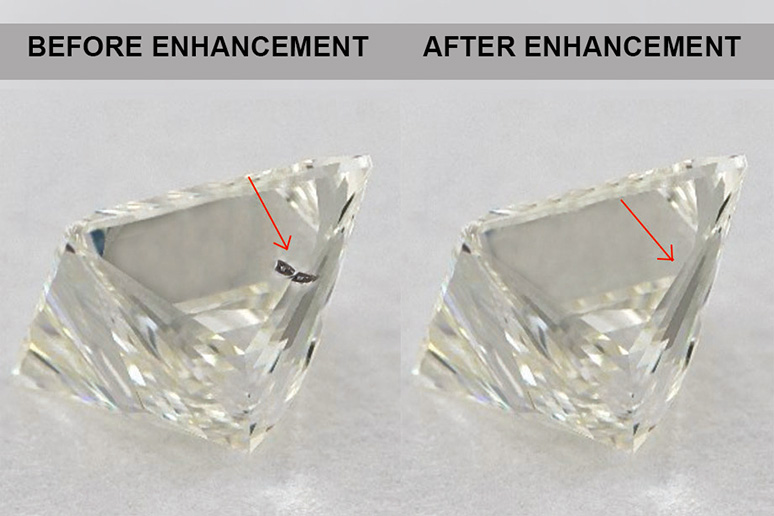
Can I Tell if my Diamond is Clarity Enhanced?
In most places where clarity enhanced diamonds are sold today, including the US and throughout Europe, laws require that these diamond merchants fully disclose that a diamond has been treated at the time of purchase. Such regulating agencies like the CIBJO and the US Federal Trade Commission help to spell out requirements to all sellers in plain language. Remember that a clarity enhanced diamond which has been fracture filled will never have a GIA certificate since it is not a permanent treatment. As stated previously however, GIA does grade diamonds which have undergone enhancement measures via laser drilling or HPHT (meaning high pressure and high temperature) methods.
How to Care for Clarity Enhanced Diamonds
While the majority of clarity enhanced diamonds have been treated by the fracture-filling which was injected into the stone using extremely high pressure, it will not come out under normal usage. There are some situations, however in which the integrity of that diamond could become compromised. So, doing your own care and cleaning of your clarity enhanced diamond is a smart way to safeguard its beauty and longevity.
To clean your clarity enhanced diamond, you may want to make a little solution of warm soapy water for cleaning the stone. Allow the diamond to rest in that soapy water for about 10 minutes. Then, using a small soft bristled baby toothbrush, give it a nice brushing to gently clean it especially on the underside where more dirt and grim has a tendency to collect. Making sure the bristles are soft avoids any scratching on the jewelry’s metal. Rinse the jewelry in tepid clean water, placing it on a fresh hand towel, and allow it to completely air dry.
Conclusion
A decade or so ago, there was some confusion in the marketplace about what exactly was a clarity enhanced diamond. The early mis-information and controversy surrounding clarity enhanced diamonds was due to lack of education in the general public about what clarity enhanced diamonds really were. Some consumers erroneously believed that they weren’t really genuine earth mined diamonds like other diamonds found in jewelry stores. Today so much real information is accessible from jewelers and on the internet. Now shoppers understand that clarity enhanced diamonds are an attractive diamond option for all their jewelry needs. In a nut shell, a clarity enhanced (or treated) diamond is a genuine mined diamond in which modern technology has been applied, making it appear higher in clarity, and more brilliantly reflective. Consumers looking for that larger diamond with plenty of ‘wow-factor’ for at very attractive prices will want to consider a clarity enhanced diamond as an appealing option—and a part of their overall smart shopping decisions. There couldn’t be a better time for consumers to buy clarity enhanced diamonds since market demand has created a wide array of carat size diamonds in the most coveted diamond shapes and even clarity enhanced color diamonds.
